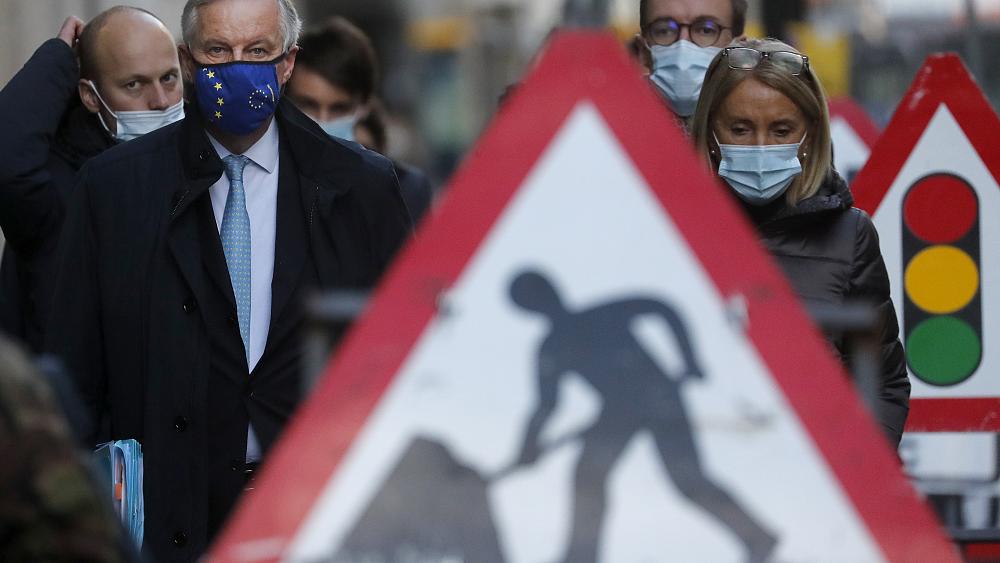
Even if the EU and the UK succeed at this late, late stage in striking a post-Brexit trade deal, a new race against time will begin.
An agreement needs to be ratified on both sides to ensure it comes into force by January 1 after the transition period expires.
“Crunch” weeks have come and gone, as has Boris Johnson’s mid-October deadline. In June EU negotiator Michel Barnier said a full legal text would be needed “by 31 October at the latest”. Experts in procedure later said agreement would have to be reached by mid-November, and that has passed too.
In football terms, we are now deep into stoppage time and several minutes beyond the number flashing on the touchline electronic board.
Overcoming the familiar obstacles relating to fishing rights, future competition and an enforcement mechanism is likely to require some imagination and a brave political leap.
If a Brexit rabbit is suddenly pulled out of the hat, the UK and especially the EU will then need to pull out all the procedural stops.
EU ratification — not a simple process
On the EU side, an agreement struck by the Commission would need the backing of national leaders in the European Council, and the European Parliament. Michel Barnier has kept national envoys regularly updated on progress during the negotiations, with little sign of disunity.
Firstly, a deal needs to be turned into legal text. This involves a process known as “legal scrubbing”, to ensure it is legally robust. The range of topics expected to be covered is huge: among them trade in goods and services, fishing and farming, aviation, security cooperation, data policy, education and science.
Reports quoting officials suggest a future treaty could run to 1,800 pages — three times the length of the Withdrawal Agreement in the divorce deal that took the UK out of the EU last January.
Translation from English into the EU’s 23 other languages is likely to be a formidable task. However, despite the deadlock on key issues a draft is said to be 95% complete, and it’s thought some translation may be done in advance.
The deal would need ratification from the European Parliament, by a simple majority of all votes cast. MEPs cannot make amendments, but some have made it clear that they are not going to rubber-stamp an agreement but give it thorough scrutiny.
The parliament can speed up its procedures, by for instance waiving its committee stage which normally produces a report for MEPs with recommendations. However, passing such an important and far-reaching deal in under a month would be a tall order.
The last plenary session of the European Parliament is in mid-December, so MEPs may have to organise a special meeting in the week after Christmas to vote on a deal.
Some policy areas may come under what is known as “mixed” or “shared” competence, meaning subject also to the approval of national and even regional assemblies. Member states can collectively decide to limit ratification to EU level, but several are certain to want to analyse the text in detail including in their parliaments.
After the European Parliament’s consent, the deal would return to the Council to be formally adopted.
UK approval should be easier than last time
Ratification on the British side should be simpler, not least because of the 80-strong majority enjoyed by Boris Johnson’s government. A repeat of the acrimonious parliamentary deadlock that repeatedly delayed Brexit itself is highly unlikely.
By law, the government can ratify a treaty 21 sitting days after it is laid before parliament. The process can be speeded up if necessary. If MPs vote against it, a further 21-day period kicks in. However, under Brexit legislation already passed the government is not obliged to hold a vote.
Further legislation may be needed though to implement an EU-UK treaty. UK parliamentary managers have reportedly drawing up legislation in anticipation of a deal, in order to get it passed in time for January 1.
What happens if the process runs out of time?
Throughout the autumn, commentators have said time is running out to strike a deal. Commission President Ursula von der Leyen told MEPs on Wednesday (November 25) that these were now “decisive days”.
EU officials have often said that Brussels will not pull the plug on talks, but it may have to announce that ratification is no longer possible by December 31.
Boris Johnson’s government refused an extension to the post-Brexit transition period, which since the summer has been legally impossible anyway under the terms of the divorce deal. One possibility might be for the EU and the UK to agree to apply a deal provisionally, pending ratification.
Much may depend on whether there is any political will to reach an agreement. Otherwise contingency plans are likely to come into play for a “no-deal scenario”.
 RSS Feed
RSS Feed















 November 27th, 2020
November 27th, 2020  Awake Goy
Awake Goy  Posted in
Posted in  Tags:
Tags: 













